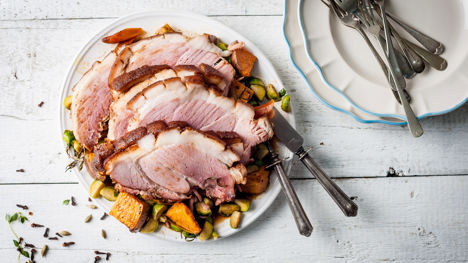Roast gammon is a dish traditionally served up at Christmas time for Boxing Day dinner – the richly succulent and saline meat can be served hot or cold and is treasured by most carnivores. But there is no reason why roast gammon should not be enjoyed all year round; it is as well suited to a summery roast dinner - alongside seasonal ingredients like peas, asparagus or even fennel, as it is to a cockle-warming winter dinner.
Scoring the skin before roasting is a must to help render down the fat and ensure mouth-wateringly crisp skin. For ease of serving, try and choose a gammon joint which has no bone and is already rolled by a butcher.
Metric
Imperial
- 2kg gammon, boned and rolled
- 2 onions
- 3 celery sticks
- 3 carrots
- thyme, (optional)
- 2 onions, quartered
- 3 celery sticks, roughly chopped
- 3 carrots, roughly chopped
- 1 garlic bulb, halved widthways
- 1 handful of thyme sprigs
- 2 tbsp of wholegrain mustard
- 2 tbsp of honey
- 1 tsp cider vinegar
- 1 tsp brown sugar
- 1 tbsp of vegetable oil
Method
Variations
For a quicker option, after soaking the gammon (step 1) try wrapping the joint in a silver foil parcel and roasting for 20 minutes in an oven set to 170°C/gas mark 3, then finish by glazing in a marinade and crisping up in the oven for 30 minutes at 220°C/ gas mark 7. If choosing this option, make sure the joint has a good amount of fat, as this will help to keep the gammon moist as it cooks.
Dominic Chapman uses a traditional method to bake his gammon. By coating the meat in a bran paste before cooking long and slow, the meat is permeated with a pleasant nuttiness and is kept moist by the protective bran coating.
Uses
The most common flavours matched to roast gammon are honey and cloves, complementing the rich, salty quality of the meat. Why not branch out a little when next serving roast gammon - James Mackenzie pairs gammon with scrumpy cider and Emily Watkins serves her gammon lardons with a pea salad, as well as a twist on the traditional egg.
In terms of marinades and glazes, Josh Eggleton recommends using a honey, mustard and clove mix to coat the gammon before it is roasted - mustard and cloves adds piquancy while honey gives the meat a slightly sticky and sweet finish. This is also the case with marmalade or maple syrup - both great ingredients to smear onto gammon prior to roasting.
Get in touch
Please sign in or register to send a comment to Great British Chefs.



